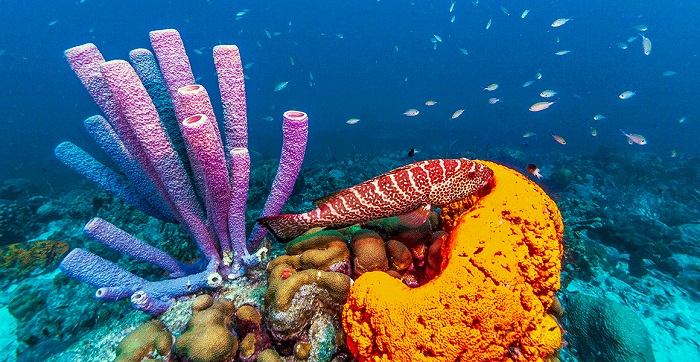
02 Aug Unveiling the underwater wonders: the enigmatic life of sea sponges
Deep beneath the ocean’s surface, a remarkable yet often overlooked group of organisms thrives: sea sponges. Despite their seemingly simple structure, these ancient creatures are marvels of evolutionary design. Their fascinating biology and unique adaptations reveal secrets of life in the deep. From their intriguing feeding mechanisms to their unconventional modes of movement and reproduction, sea sponges offer a glimpse into one of the ocean’s most enigmatic inhabitants.
A Glimpse into Sponge Anatomy and Sensory Perception
Sea sponges in the ocean belong to the phylum Porifera, which translates to “pore bearer”—a fitting name for these porous organisms. They lack true tissues and organs but have a body structure defined by a network of pores and channels. Water flows through these openings, which are critical for their survival.
One might expect that such simple creatures lack advanced sensory systems, but sea sponges are surprisingly perceptive. They lack eyes and a nervous system but can still detect and respond to environmental changes. This sensitivity is believed to stem from their ability to respond to chemical cues and fluctuations in their environment. For instance, sponges can react to changes in water chemistry, light levels, and even the presence of potential threats, albeit in a manner different from more complex organisms.
The Art of Feeding: Sponge Filter Mechanics
The primary mode of nourishment for sea sponges is filter feeding, a process as efficient as it is fascinating. Sea sponges draw water into their bodies through numerous small pores called ostia. Inside, specialized cells known as choanocytes, or collar cells, line the internal channels. These cells have tiny, whip-like structures that create water currents and trap microscopic particles, including plankton and bacteria.
Once the particles are captured, they are engulfed by the choanocytes and digested. The cleaned water is then expelled through a larger opening called the osculum. This process not only sustains the sponge but also contributes to the filtration of the surrounding water, improving water quality in their habitat.
Movement: The Art of Staying Put
Unlike many marine organisms, ocean sponges are sessile, meaning they do not move from place to place. Instead, they remain fixed to a substrate, such as rocks or coral. While they don’t move in the traditional sense, they do exhibit a kind of slow-motion rearrangement. Some sponges can reorient their growth in response to environmental conditions, such as light or water flow, which might be considered a form of passive movement.
In their early life stages, sponge sea larvae are free-swimming, allowing them to disperse to new locations. Once they settle and mature, they attach firmly to a surface and begin their life as an immobile adult. This sessile lifestyle, combined with their efficient filter-feeding capabilities, makes them crucial players in their ecosystems.
Reproduction: The Dual Strategy of Sponges
Ocean sponges are masters of adaptation, employing both sexual and asexual reproduction to ensure their survival. Asexual reproduction occurs through processes like budding or fragmentation. In budding, a part of the sponge breaks off and develops into a new individual. Fragmentation involves a piece of the sponge breaking off and regenerating into a complete organism. These methods allow sponges to proliferate rapidly and colonize new areas.
Sexual reproduction in sea sponges is equally fascinating. Sponges are typically hermaphroditic, possessing both male and female reproductive organs. They release sperm into the surrounding water, which is then taken up by other sponges. Fertilization occurs internally, and the fertilized eggs develop into larvae within the parent sponge. These larvae are then released into the water column, where they swim freely before settling on a suitable substrate to grow into adult sponges.
Conclusion: The Marvels of the Sponge World
Sea sponges, with their ancient lineage and unique characteristics, are much more than their simple appearance might suggest. Their remarkable feeding systems, passive movement, and versatile reproductive strategies illustrate the complexity and adaptability of life in the marine environment. As we continue to explore and understand these enigmatic organisms, sea sponges remind us of the incredible diversity and resilience of life beneath the waves. Their secrets, from their sensitive nature to their ingenious methods of survival, make them a captivating subject of study and a vital component of our oceanic world.



No Comments